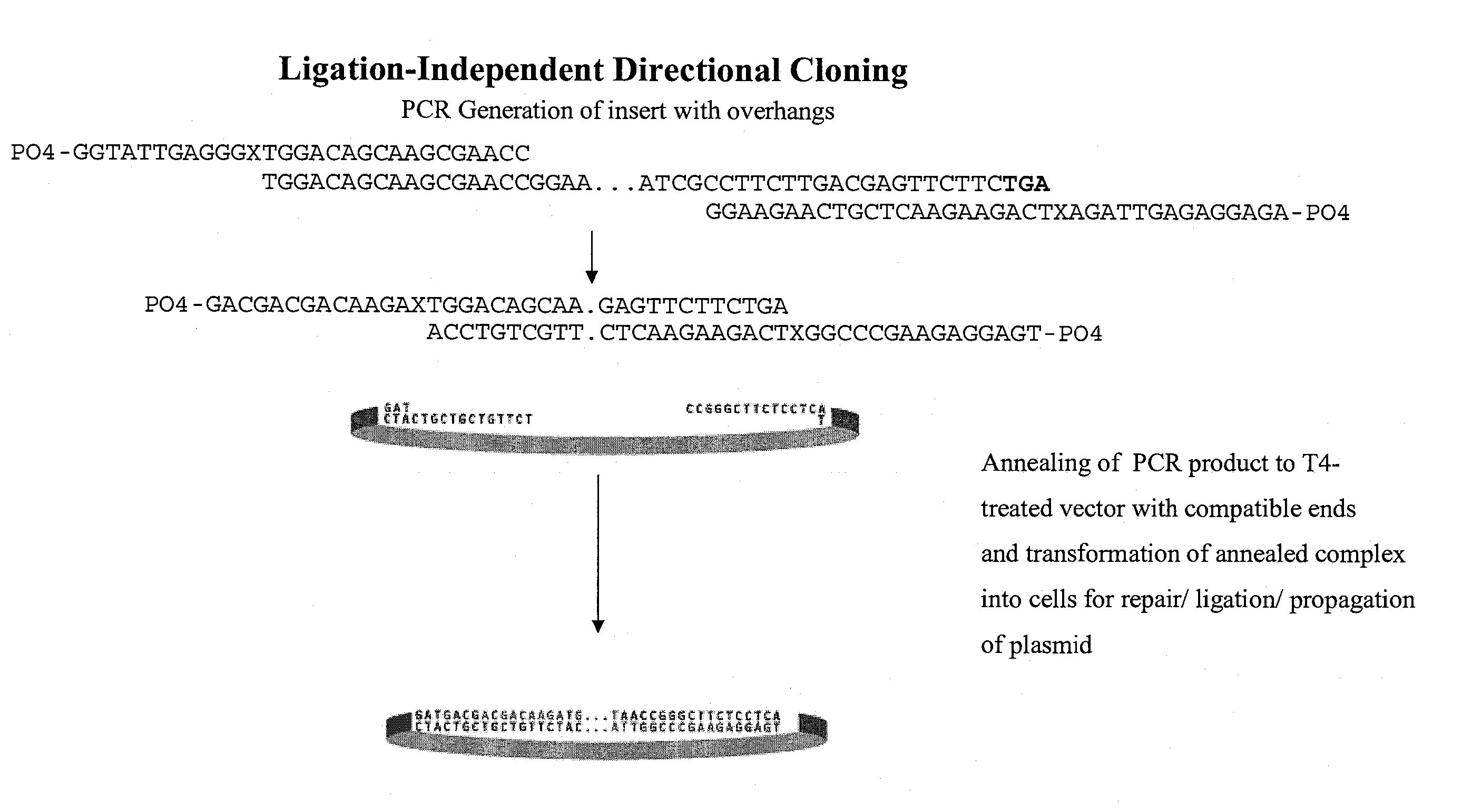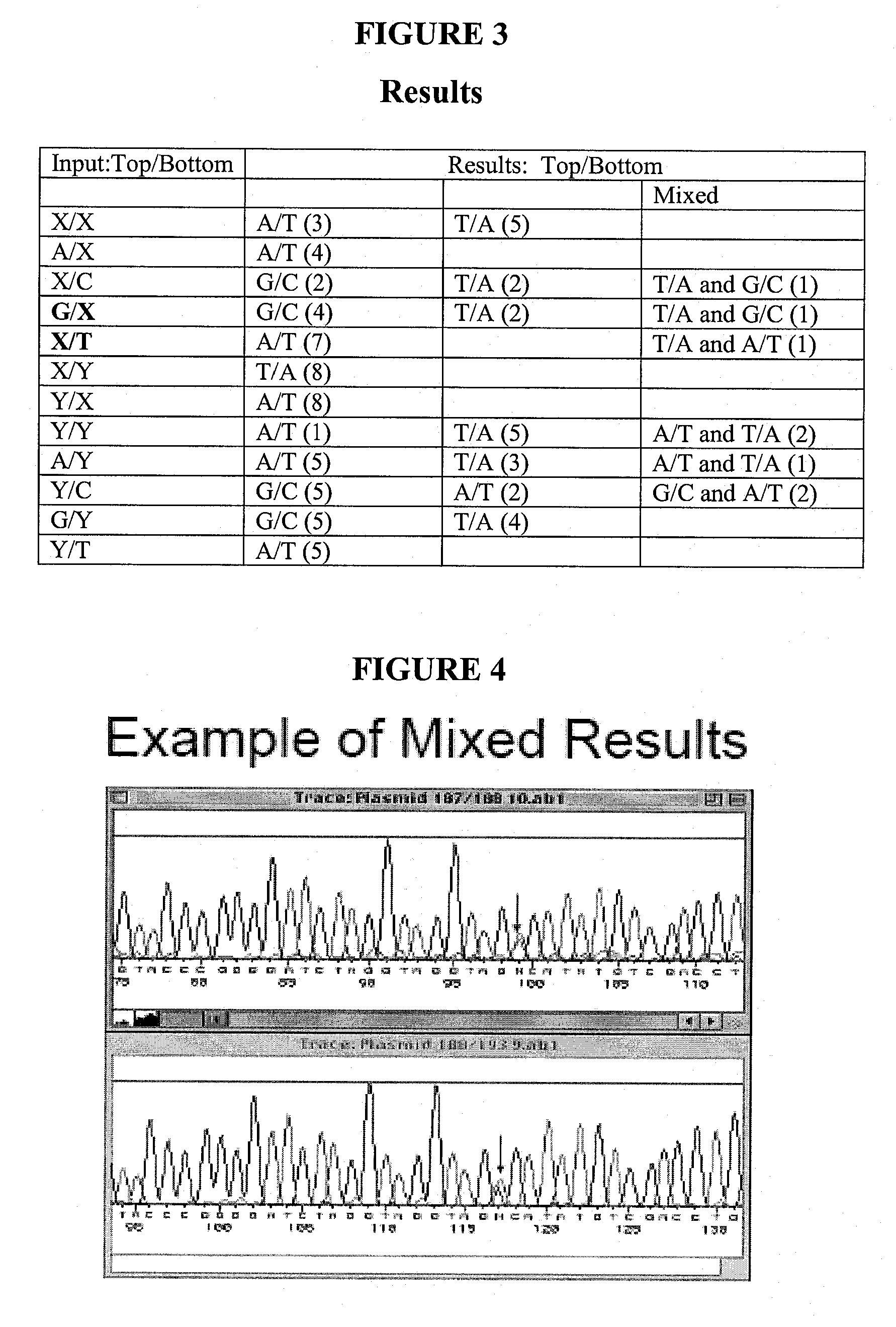Use of non-standard bases and proximity effects for gene assembly and conversion of non-standard bases to standard bases during DNA synthesis
a technology of proximity effect and non-standard bases, applied in the field of biochemistry, can solve the problems of inability to obtain the level of hybridization specificity needed for accurate multi-oligonucleotide assembly, increase the preparation time, and increase the cost. , to achieve the effect of improving annealing specificity and molecular recognition, increasing the rate and reproducibility
- Summary
- Abstract
- Description
- Claims
- Application Information
AI Technical Summary
Benefits of technology
Problems solved by technology
Method used
Image
Examples
example 1
[0133] According to the described methods, ligation-dependent directional cloning of a kanamycin resistance gene was performed (FIG. 6). The insert was generated using PCR amplification of the Neo gene and promoter from pCR4TOPO plasmid using the following primers:: JP165: PO4—CTAXTGGACAGCAAGCGAACC and JP166: PO4-AATXTCAGAAGAACTCGTCAAGAAGG. As a positive control, the same sequence was amplified using primers containing EcoRI and XbaI sites: JP152: PO4-GCTCTAGATGGACAGCAAGCGAACC and JP155: PO4-GGAATTCTCAGAAGAACTCGTCAAGAAGG. The following enzymes were used: Stratagene cloned Pfu / 1×Pfu buffer; Roche Pwo / 1×Pwo buffer; Epicentre Tfl / 10 mM BTP pH 9.1, 40 mM Kac, 2 mM MgCl2; Epicentre Tfl / 1×Tfl buffer (1); Tth / 1×Tth buffer (2); Klentaq / 10 mM BTP pH 9.1, 40 mM Kac, 2 mM MgCl2; Amplitaq / 10 mM BTP pH 9.1, 40 mM Kac, 2 mM MgCl2; (Note: Amplitaq also used to amplify 152 / 155 control insert). Other reagents included (at final concentration: 200 mM dNTPs, 0.5 μM primers, ...
example 2
[0136] According to the described methods, ligation-independent directional cloning of a kanamycin resistance gene was performed (FIG. 9). The insert was generated using PCR amplification of the Neo gene and promoter were from pCR4TOPO plasmid using the following primers: JP169: PO4-GGTATTGAGGGXTGGACAGCAAGCGAACC and JP170: PO4-AGAGGAGAGTTAGAXTCAGAAGAACTCGTCAAGAAGG. 50 μl PCR reactions each contained: 2.5 U Pfu DNA polymerase; 0.5 μM JP169 / 170; 200 mM dNTPs; ˜1 amol pCR4TOPO. Cycling was conducted at 95° C., 2 min, then 38 cycles of 95° C., 10 sec; 58° C., 5 sec; 72° C., 1 min. The PCR products were treated with BM High Pure PCR purification kit, eluted in H2O, and adjusted to 50 mM Tris pH 8, 10 mM MgCl2, 1 mM rATP. Annealing reactions were performed with or without T4 ligase, according to standard conditions. All reactions were incubated at room temp for 5 min. Then 1 μl 25 mM EDTA was added and incubated 5 min, followed by transformation into NovaBlue ...
example 3
[0137] One of the ROC experiments that we performed was to generate an “ABC” chimera through separate amplification of the “A” (the hGluR2Flop exon), “B” (intron 1 from the human β-globin gene), and “C” (the hGluR2Flip exon) fragments, followed by ligation of the amplified products.
[0138] When introduced into competent cells, longer overhangs (e.g., 13 nucleotides) can be ligated into the appropriate vectors by the endogenous ligases, negating the need for a prior ligation step.
[0139] The overhangs can be used to recombine DNA fragments at most any sequence location, creating chimeric genes composed of DNA fragments that have been joined without the insertion, deletion, or alteration of even a single base pair.
[0140] To create 5′ overhangs using these chimeric primers in the amplification reactions, a thermostable DNA polymerase that did not copy RNA was used. Vent polymerases were reported not to have such activity (unless Mn2+ was added to the reaction buffer). Therefore, a pol...
PUM
| Property | Measurement | Unit |
|---|---|---|
| distance | aaaaa | aaaaa |
| distance | aaaaa | aaaaa |
| distance | aaaaa | aaaaa |
Abstract
Description
Claims
Application Information
 Login to View More
Login to View More - R&D
- Intellectual Property
- Life Sciences
- Materials
- Tech Scout
- Unparalleled Data Quality
- Higher Quality Content
- 60% Fewer Hallucinations
Browse by: Latest US Patents, China's latest patents, Technical Efficacy Thesaurus, Application Domain, Technology Topic, Popular Technical Reports.
© 2025 PatSnap. All rights reserved.Legal|Privacy policy|Modern Slavery Act Transparency Statement|Sitemap|About US| Contact US: help@patsnap.com



